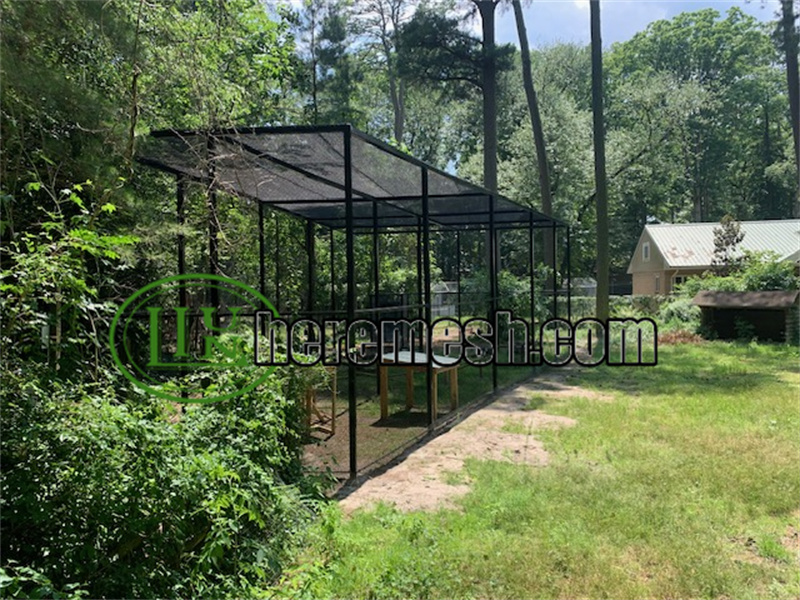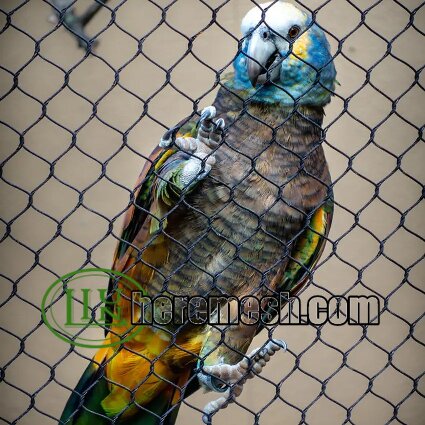Aviary Wire Mesh: The Ultimate Choice for a Safe and Healthy Aviary

Liulin Black Oxide Zoo Mesh Order for Chimpanzee Enclosure
04/07/2025In the construction of modern zoos, bird sanctuaries, eco-parks and even private aviaries, the choice of aviary material is crucial. It not only determines the safety and health of the birds, but also affects the viewing experience of visitors. And it also affects the long-term maintenance cost of the facility. Among many materials, stainless steel aviary wire mesh has become the preferred solution for aviary construction due to its excellent durability, safety and aesthetics. This article will delve into the advantages of aviary mesh and application scenarios.
Aviary wire mesh introduce
Aviary wire mesh is a special enclosure structure dedicated to bird feeding and display sites. Bird protection mesh plays multiple functions such as protection, display and education. This kind of mesh structure is different from the ordinary construction mesh. It needs to meet the physiological needs of birds, the viewing needs of tourists and the management needs of venues at the same time. In the construction system of modern zoos and aviaries, birdhouse nets are gradually transformed into a comprehensive solution combining ecology and art.
Early designers built aviary mesh mainly considering cost factors and basic protection functions, often using ordinary wire simple enclosure. This material is prone to rust and breakage. Sharp welded joints and burrs often caused feather damage or skin scrapes to birds. With the concept of animal welfare, modern zoos commonly use high-end materials such as stainless steel rope mesh. These materials not only offer excellent corrosion resistance, but also provide safer contact surfaces.
The core advantage of stainless steel aviary wire mesh
In every respect, contemporary zoo aviary wire mesh have gone beyond simple spatial isolation. Traditional aviary mesh are often barbed wire, nylon nets or galvanized nets. However, these materials are easy to rust, easy to age, lack of strength and other problems, long-term use may lead to bird injury or escape. The stainless steel rope mesh fundamentally solves these pain points.
1. Unmatched corrosion resistance
Stainless steel rope mesh is made of 304 or 316 stainless steel. It is extremely resistant to oxidation. It maintains stable performance in both humid climates and at high altitudes with extreme temperature differences. This characteristic makes it ideal for permanent aviary, dramatically reducing long-term maintenance and replacement costs.
2. High strength and flexibility
The woven structure of stainless steel rope mesh gives it excellent tensile strength. It can withstand the scratching of raptors, the impact of large birds, and even extreme weather (such as strong winds). At the same time, its flexible nature cushions birds from flying collisions, reducing the risk of injury and making it safer than rigid wire mesh.
3. Bird-friendly design
Welded points or sharp edges of ordinary metal mesh may cut birds, while stainless steel rope mesh adopts woven technology. The surface is smooth and burr-free, ensuring that birds will not scratch their feathers or skin upon contact. In addition, its mesh size can be customized for different bird species, preventing both small birds from escaping and raptors from getting their claws stuck. The new stainless steel rope mesh material is safe and non-toxic and does not harm birds in any way.
4. Very low maintenance requirements
Stainless steel aviary wire mesh requires little to no special maintenance. Stainless steel rope mesh does not need to be painted to prevent rust. It only needs to be rinsed with water on a daily basis to keep it clean. It is ideal for zoos, bird sanctuaries, and other places that require long-term stable operation.
5. Beauty and transparency
Traditional metal mesh often looks stiff and detract from the viewing experience. The stainless steel aviary wire mesh, however, has slim lines and little visual interference, allowing visitors to observe the natural behavior of birds more clearly. Its silver-white or black coating (optional) better blends into the natural environment and enhances the overall aesthetics of the landscape.


Application of stainless steel rope mesh in aviary construction
Stainless steel aviary wire mesh is extremely versatile, covering almost all bird captive environments.
1. Large bird flight cage
Large birds such as eagles, eagles and cranes need a wide space for flight. The high strength and flexibility of stainless steel rope mesh can ensure that the cage body will not be deformed when the birds fly at high speed, and at the same time avoid injuries caused by impact.
2. Tropical aviary and Waterfowl exhibits
Humid environments tend to accelerate metal corrosion, but 316 stainless steel rope mesh has stronger corrosion resistance. 316 stainless steel is ideal for parrot aviary, flamingo pools, and other scenarios. And it won’t rust when immersed in water for long periods of time.
3. Small birds and ornamental bird aviary
For hummingbirds, finches and other small birds, a finer mesh can be used to prevent escape without impeding their freedom of movement.
4.Open ecological bird garden
Modern zoos tend to create immersive birdhouses. Stainless steel aviary wire mesh can be used with steel frame structures to build oversized span domes. It allows birds to live in a semi-free state while ensuring the safety of visitors.
Balance in the zoo aviary wire mesh to release the pressure of birds, restore the original habitat of birds
In the design of zoo aviaries, the core of balancing open displays with the well-being of the birds is to mimic the natural habitat while reducing the stress of human disturbance. Stainless steel rope mesh, a commonly used material, has the advantage of durability and corrosion resistance. The diameter and mesh size should be as fine as possible to ensure that it does not cause damage to bird feet. A black oxidized material is preferred for the color so that it blends into the background of the vegetation.
The spatial structure of the bird aviary needs to break the geometric symmetry and adopt an irregular three-dimensional layout. Combine different types of trees, running water and other installations in the aviary to create a natural habitat. This design helps to stimulate the natural behavior of the birds and promotes their healthy growth.


Stainless steel rope mesh installation and optimization suggestions
Despite the superior performance of stainless steel rope mesh, it is the correct installation that maximizes its effectiveness. Here are the key considerations.
1. Choose the right mesh size
Large raptors (eagles, vultures): 50 mm x 50 mm or larger to avoid claws getting stuck.
Medium-sized birds (parrots, peacocks): 25 mm x 25 mm or 30 mm x 30 mm.
Small birds (finches, hummingbirds): 10 mm x 10 mm or customized smaller mesh.
2. Ensure stable structure
Stainless Steel Rope Mesh needs to be equipped with high strength supporting frame (such as galvanized steel pipe or aluminum alloy) and professional tensioning system to avoid loosening and deformation due to long-term stress.
3. Mesh fixing method
Stainless steel clips are recommended to be used for fixing, instead of ordinary wire binding, to ensure long-term stability.
4. Combined with ecological design
Vines and plants can be climbed on the rope netting, which can enhance the natural beauty. And it provides additional shelter and roosting points for birds.
Conclusion
In the construction of bird conservation and display facilities, the choice of materials has a direct impact on animal well-being and operational efficiency. Stainless steel aviary wire mesh with its excellent performance and wide applicability, has become the best choice for modern aviaries. Whether it is a zoo or a bird park, choosing a stainless steel rope net is choosing a safe, healthy and lasting aviary solution. The application of stainless steel aviary mesh is conducive to building a safe and comfortable living environment for birds. Stainless steel rope mesh does not require frequent cleaning and maintenance, reducing later maintenance costs. One input, reuse. In the future, with the advancement of technology, stainless steel rope mesh will be further upgraded in terms of lightweight.


